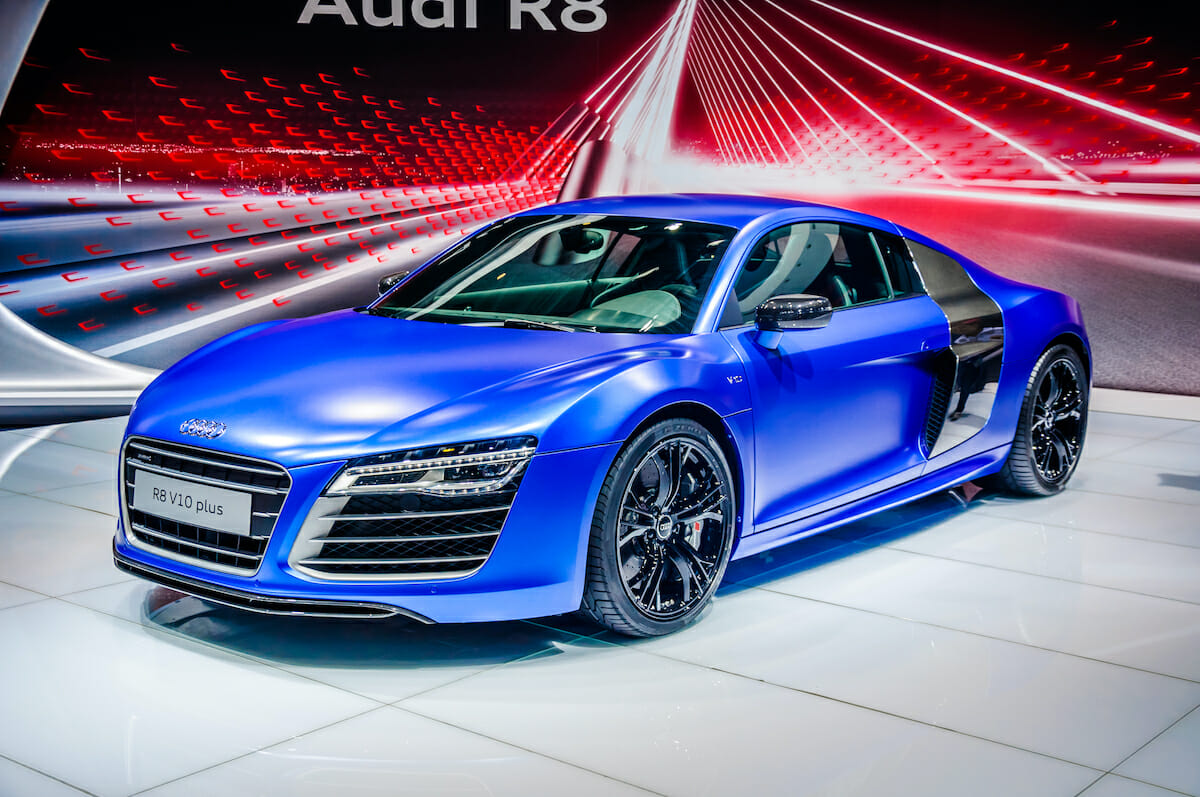
The Audi R8 has been the brand’s halo car for 15 years. With electrification on the horizon, Audi has all but confirmed the end of its beloved 5.2-liter V10 is near. As one of the last Formula 1-inspired, naturally aspirated mid-engine supercars still on the market today, the Audi R8’s V10 has solidified its place in automotive history thanks to years of engineered excellence.
What are the Specs for the Audi R8’s V10?
The 2021 Audi R8 V10 throws down 532 horsepower and 398 lb-ft. of torque. An intake manifold fuel injection and cylinder deactivation system help balance the raw power of the R8’s V10 with improved efficiency.
As Audi’s premier luxury performance supercar, the R8’s 10-cylinders will come at a hefty price. Vehicle History has everything you need to know on what to expect when it comes to ownership and maintenance costs for an Audi R8 V10.
History of the Audi R8 V10
The Audi R8 first launched in 2006, but it was not until 2009 that Audi would introduce the 5.2-liter V10 to the R8 engine bay. At first, the Audi-engineered V10 made 525 horsepower and 391 lb-ft of torque, pushing the R8 from 0-60 in 3.9 seconds.
The naturally aspirated V10 features Audi’s dual-injection, Fuel Stratified Injection (FSI) system, which was originally developed for the Le Mans endurance races. Under light loads, port injection feeds fuel into the intake runner for smoother start-up operations. As the engine revs higher, direct injection kicks in to supply about 85% of the total fuel needed, which improves cooling and therefore increases engine power.
Additionally, the Audi V10 benefits from a unique crankshaft and dry sump lubrication system. This allowed Audi to mount the V10 lower in the R8’s engine bay for a decreased center of gravity, and reduced issues related to oil starvation.
In 2015, when the second-generation R8 launched, Audi updated its V10 to include intake manifold fuel injection to improve emissions. In addition, a cylinder on demand (COD) system was added, which enabled the R8’s V10 to disable up to five cylinders under partial-load operations. Thanks to these updates, the engine can rev higher, faster. Peaking at 8,700 rpm, each piston fires through the cylinder at a rate of 60.2 mph. For comparison, Formula 1 engine pistons move at 58.2 mph.
The speed and firing pattern of the R8’s 10-cylinders are responsible for its distinct engine note. With the cylinders firing at 1-6-5-10-2-7-3-8-4-9, as the engine approaches peak rpms, the exhaust system opens baffles that give way from a loud hiss to a deep bass effect that offers the most pristine automotive acoustics.
In its most potent form, the Audi R8 Performance V10 threw down 602 horsepower and 413 lb-ft of torque, moving the R8 to 60 mph in 3.2 seconds thanks to all-wheel-drive and a seven-speed dual-clutch gearbox. In Europe, the Audi R8 Performance was rated even higher at 612 horsepower, and 428 lb-ft of torque. However, American models get a louder exhaust.

Is This the Same V10 Found in Lamborghinis?
Yes. The Audi R8’s V10 is derived from the 2003 Lamborghini Gallardo, which used a 5.0-liter V10 designed and developed in-house by Lamborghini. After Lamborghini was acquired by Audi, the German automaker reengineered the 5.0-liter V10 from a 3.46-inch cylinder bore spacing and 72-degree firing interval, to its present-day 5.2-liter V10 featuring 3.54-inch cylinder bore spacing and an uneven firing interval of either 54- or 90-degree separation.
What is the Top Speed of the Audi R8?
The 2021 Audi R8 with the 5.2-liter V10 has a top speed of 201 mph.
Is the V10 in the Audi R8 Reliable?
Audi’s road racing history is a testament to the reliability of the R8’s V10. Thanks to smaller, lighter pistons, the engine is able to rev more freely. In addition, with fewer moving parts than a V12, reduced complexity and friction supplement engine reliability.
Audi says the V10 enjoys one of the longest recommended service intervals in the racing world. Service is recommended every 6,200 miles with a complete rebuild required every 12,400 miles.
To back up the Audi R8’s reliability, Audi offers a 4-year/50,000-mile basic comprehensive warranty, and a 4-year/50,000-mile powertrain warranty. Corrosion projection is in place for 12 years with unlimited mileage. Additional coverage is offered in the form of extended warranties that provide coverage for up to 10 years/120,000 miles.
Does the Audi R8’s V10 Require Special Maintenance?
Maintenance for an Audi R8 is relatively similar to that of the rest of the Audi lineup:* Oil and oil filter changes occur first at 10,000 miles or 1 year. Thereafter, every 20,000 or 2 years;* Brake fluid gets replaced every 2 years regardless of mileage;* Brake system gets serviced first at 10,000 miles or 1 year. Thereafter, every 20,000 or 2 years;* Battery is checked every 20,000 miles or 2 years, whichever occurs first; and* Tire pressures and wear and tear are checked first at 10,000 miles or 1 year. Thereafter, every 20,000 miles or 2 years.
Other recommended services include lubrication of all locks and the hood latch. In addition, owners can expect to service the front axel after 120,000 or 10 years.

What Will Servicing the Audi R8’s V10 Cost?
With its $142,700 MSRP, owners should expect to spend a little more on maintenance for the upkeep of the Audi R8. Estimated annual maintenance costs range between approximately $1,500 to over $5,000. For comparison, annual maintenance costs for a basic Toyota Camry come in at about $600.
Audi offers pre-paid maintenance plans that help lock in Audi Service for up to 90,000 miles. Prices for the Audi Care and Audi Care Select plans range from $699 to $1,179, depending on model and age.
